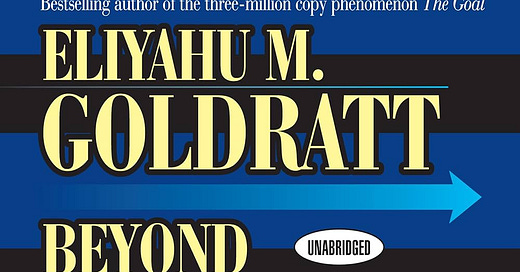Stop optimizing what doesn't matter
What a manufacturing legend taught me about business, bottlenecks, and focus
Beyond the Goal: Eliyahu Goldratt Speaks on the Theory of Constraints | Eliyahu M. Goldratt
If you’ve ever found yourself pushing hard, launching new initiatives, working late, and still not getting results, you’re not alone. You might just be solving the wrong problem.
That’s the premise behind Eliyahu Goldratt’s Beyond the Goal, a sharp, no-nonsense collection of lectures that extends the ideas he first introduced in his business classic The Goal. This isn’t light reading. But if you’re a business owner, marketer, or team leader with too many priorities and too little traction, it might be exactly what you need.
The big idea
Goldratt’s central thesis is simple and disruptive:
Every system has a constraint. Until you fix that constraint, nothing else matters.
Most businesses try to improve everything all at once—what Goldratt calls “local optimization.” That’s a trap. If your sales team is closing deals but operations can’t deliver, fixing sales won’t move the needle. If marketing’s generating leads but proposals get stuck for two weeks, more leads just clog the system.
TOC explained
Eliyahu Goldratt’s philosophy is based on his Theory of Constraints (TOC), a management philosophy that asserts the following:
“Every system has at least one constraint that limits its performance.”
The key idea:
Find the constraint, focus all improvement efforts there, and elevate it—because improving anything else won’t significantly boost overall performance.
TOC follows a five-step process:
Identify the system’s constraint (the bottleneck).
Exploit it (make the most of what it can currently do).
Subordinate everything else to support the constraint.
Elevate the constraint (increase its capacity).
Repeat—once a constraint is broken, find the next one.
The core insight: Optimizing the whole system depends on addressing its weakest link, he says.
TOC in action
In one example, a factory kept missing deadlines. Leaders blamed everything from logistics to lazy workers. The real issue? Too much material being released into production. Once they addressed that constraint, everything improved—throughput, delivery times, even morale.
His advice:
Stop asking, “How do we get better at everything?”
Start asking, “What’s the one thing that’s holding us back?”
Who this helps
If you’re in charge of growth, client success, or delivery—this is for you. Goldratt worked with manufacturers, tech startups, healthcare systems, and even the Israeli military. The lesson was always the same: You can’t fix what you don’t focus on.
One of my favorite stories: A company with a bloated sales pipeline but poor conversion. The team kept investing in lead gen (because that’s what they knew). But TOC revealed the true problem: slow proposal turnaround. Fix that, and revenue followed.
This is especially relevant for:
Marketers chasing metrics that don’t lead to revenue
Consultants juggling too many clients and proposals
Executives who feel like they’re working hard but going nowhere
What happens when you ignore it
Goldratt is blunt about the consequences. If you ignore your constraint, you don’t just stall progress—you create new problems. One plant manager tried to maximize machine use. The result? Inventory piled up, costs rose, customers left. It looked efficient but was killing the business.
We see this today when:
Marketers chase impressions over impact
Sales teams are rewarded for calls instead of closes
Leaders applaud motion instead of progress
Without clear alignment around the real constraint, you end up rewarding the wrong behaviors—and worsening the bottleneck you should be fixing.
What happens when you get it right
Once you identify and address the constraint, change accelerates. Goldratt describes a company that routinely missed project deadlines. After applying TOC’s Critical Chain Project Management, they overhauled how they scheduled work. The result? 30% faster delivery times and happier clients.
In your world, this could mean:
Pausing low-ROI campaigns to fix onboarding
Automating proposal generation before scaling outreach
Delaying a product launch until ops is ready to deliver
It’s not about doing less. It’s about doing less of what doesn’t matter.
Big friggin’ deal
Local optimization ≠ global improvement.
“Until you address the true constraint, nothing else you do will move the needle.”
Bottom line
Beyond the Goal is Goldratt at his best—clear, direct, and refreshingly unafraid to challenge the way most businesses operate.
He doesn’t give you a step-by-step checklist. He gives you a better lens.
In a world where leaders are drowning in data and starving for direction, this book delivers clarity: Find the bottleneck. Fix it. Then move on to the next challenge.




